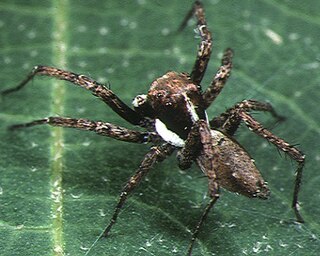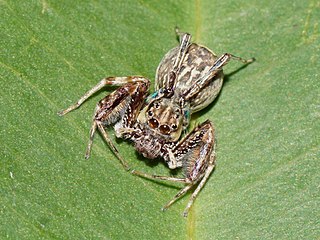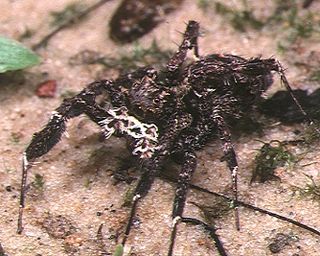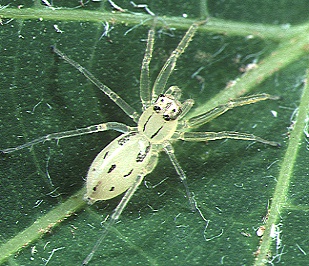
Jumping spiders are a group of spiders that constitute the family Salticidae. As of 2019, this family contained over 600 described genera and over 6,000 described species, making it the largest family of spiders at 13% of all species. Jumping spiders have some of the best vision among arthropods and use it in courtship, hunting, and navigation. Although they normally move unobtrusively and fairly slowly, most species are capable of very agile jumps, notably when hunting, but sometimes in response to sudden threats or crossing long gaps. Both their book lungs and tracheal system are well-developed, and they use both systems. Jumping spiders are generally recognized by their eye pattern. All jumping spiders have four pairs of eyes, with the anterior median pair being particularly large.

Portia is a genus of jumping spider that feeds on other spiders. They are remarkable for their intelligent hunting behaviour, which suggests that they are capable of learning and problem solving, traits normally attributed to much larger animals.

Portia labiata is a jumping spider found in Sri Lanka, India, southern China, Burma (Myanmar), Malaysia, Singapore, Java, Sumatra and the Philippines. In this medium-sized jumping spider, the front part is orange-brown and the back part is brownish. The conspicuous main eyes provide vision more acute than a cat's during the day and 10 times more acute than a dragonfly's, and this is essential in P. labiata′s navigation, hunting and mating.

Brettus is a genus of jumping spiders. Its six described species are found in southern Asia from India to China and Sulawesi, with a single species endemic to Madagascar.

Cocalus is a genus of jumping spiders that was first described by Carl Ludwig Koch in 1846, and is named after Cocalus, a Sicilian king of Greek mythology.

Cyrba is a genus of spiders in the family Salticidae. The genus was erected by Hippolyte Lucas in 1846.
Paracyrba is a genus of jumping spiders found only in Malaysia. It contains only one species, Paracyrba wanlessi. Its microhabitat are the water-filled hollow internodes of decaying bamboo, where it preys for aquatic animals, especially mosquito larvae. P. wanlessi and Evarcha culicivora, a jumping spider, are the only two spiders that have been experimentally studied and considered a mosquito specialist. E. culicivora indirectly feeds vertebrate blood by preying female mosquitos that carry blood. In general only one specimen is found per occupied bamboo internode.
Wanlessia is a genus of Asian jumping spiders that was first described by D. P. Wijesinghe in 1992. As of September 2019 it contains two species, both endemic to eastern Asia: W. denticulata and W. sedgwicki. It is related to Portia, and is the only member of the subfamily Spartaeinae with well-developed palpal conductors. Both species only have descriptions for males. It is named in honor of arachnologist Fred R. Wanless, who described more than a dozen salticid genera from 1970 to 1990.

The Spartaeinae are a subfamily of the spider family Salticidae. The subfamily was established by Fred R. Wanless in 1984 to include the groups Boetheae, Cocaleae, Lineae, Codeteae and Cyrbeae, which in turn were defined by Eugène Simon.

Maevia inclemens or the dimorphic jumping spider is a relatively common and colorful jumping spider of North America. In the males there are two forms, a very rare phenomenon in zoology. These use different courting displays, and differ in appearance: the "tufted" morph has a black body and pedipalps ("palps"), three black tufts across its "head", and pale legs; and the "gray" morph has black and white stripes all over its body and legs, orange palps, and no tufts. However, each form accounts for 50% of the adult males, and they are equally successful in mating. A female of Maevia inclemens is 6.5 to 8.0 millimetres long, while males are 4.75 to 6.50 millimetres long.

Portia fimbriata, sometimes called the fringed jumping spider, is a jumping spider found in Australia and Southeast Asia. Adult females have bodies 6.8 to 10.5 millimetres long, while those of adult males are 5.2 to 6.5 millimetres long. Both sexes have a generally dark brown carapace, reddish brown chelicerae ("fangs"), a brown underside, dark brown palps with white hairs, and dark brown abdomens with white spots on the upper side. Both sexes have fine, faint markings and soft fringes of hair, and the legs are spindly and fringed. However, specimens from New Guinea and Indonesia have orange-brown carapaces and yellowish abdomens. In all species of the genus Portia, the abdomen distends when the spider is well fed or producing eggs.

Portia schultzi is a species of jumping spider which ranges from South Africa in the south to Kenya in the north, and also is found in West Africa and Madagascar. In this species, which is slightly smaller than some other species of the genus Portia, the bodies of females are 5 to 7 mm long, while those of males are 4 to 6 mm long. The carapaces of both sexes are orange-brown with dark brown mottling, and covered with dark brown and whitish hairs lying over the surface. Males have white tufts on their thoraces and a broad white band above the bases of the legs, and these features are less conspicuous in females. Both sexes have tufts of orange to dark orange above the eyes, which are fringed with pale orange hairs. Males' abdomens are yellow-orange to orange-brown with blackish mottling, and on the upper sides are black and light orange hairs, and nine white tufts. Those of females are pale yellow and have black markings with scattered white and orange-brown hairs on the upper side. P. schultzi has relatively longer legs than other Portia, and a "lolloping" gait.
Portia africana is a jumping spider found in Angola, Cameroon, the Central African Republic, Gabon, Ghana, the Ivory Coast, Sierra Leone, Zaire and Zambia. Its conspicuous main eyes provide vision more acute than a cat's during the day and 10 times more acute than a dragonfly's, and this is essential in P. africana′s navigation, hunting and mating.
Brettus adonis, is a species of spider of the genus Brettus. It is endemic to Sri Lanka.
Gelotia lanka is a species of jumping spider of the genus Gelotia. It is endemic to Sri Lanka.
Brettus cingulatus is a species of jumping spider of the genus Brettus. It is found in Myanmar and India.

Lyssomanes viridis, commonly known as the magnolia green jumper, is a species of jumping spider of the genus Lyssomanes, for which it is the type species. The species' native range extends through much of North America and Central America.

Asemonea maculata is a species of jumping spider in the genus Asemonea that is endemic to Ivory Coast. The spider was first defined in 1980 by Fred Wanless. It is a small spider, with a carapace that is between 2.08 and 2.10 mm long and an abdomen typically 2.4 mm long. The carapace is amber to whitish-yellow and the abdomen whitish-yellow, both with black markings. It is similar to the related species Asemonea pinangensis and Asemonea tanikawai, but can be distinguished by the tibia on the male pedipalp. The female has not been described.
Fred R. Wanless was a British arachnologist. Active in the field especially in the seventies and eighties of the 20th century, he described several dozen taxa, in particular among the spiders of the Salticidae family. Wanless played a significant role in the British Arachnological Society being its member in 1969–1973, 1974–1976 and 1986–1989, and Meetings Secretary in 1973–1978. From 1973 to 1988 he described 137 new species and 13 new genera.

Asemonea murphyae is a species of jumping spider in the genus Asemonea that lives in Kenya and South Africa. First defined in 1980 by Fred Wanless, the spider is named after the British arachnologist Frances M. Murphy. Asemonea murphyae thrives in a wide range of environments, particularly by the side of rivers, streams and tracks. A small spider, with a carapace that is between 1.48 and 2.00 mm long and an abdomen between 2.4 mm long, it is generally yellow with a green tint that enables it to blend into its environment. The female is smaller than the male. The species can be distinguished from other spiders in the same genus by the design of the female's epigyne and the male pedipalp, particularly the male's forked spike on the palpal tibia.












